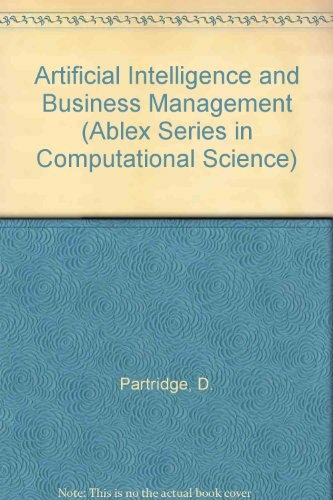Edition
Preface
PART I: INTRODUCTION
1 Artificial Intelligence: What Is It?
Is There a Definition of AI?
Can Computers Think?
Can Computers Learn?
The Samuel Phenomenon
Humans Versus Computers
Goals of AI
Subdisciplines of AI
Summary
Review and Discussion Questions
Selected Annotated Bibliography
2 Problem Solving and AI
The Nature of AI Problems
Types of Problem Solving
The Heuristic Programming Approach
Decision Trees
Decision Tables and Production Rules
Advantages of Decision Tables
AI in Problem Solving
Pattern Recognition
Language Procesing
Voice P1·ocessing
Image Processing
Expert Systems
Summary
Review and Discussion Questions
Selected Annotated Bibliography
PART II: APPLICATIONS OF AI
3 Natural-Language Processing
Natural Languages
What Mode of Natural Language
The Goals of NP
Natural Language: The Essential Ingredients
Generation and Analysis
Text Understanding Systems
Syntax, Grammars, and Parsing
Grammars
Transformational Grammars
Transition Networks, Augmented and Recursive
Unification and the New Grammatism
Semantic Definite Clause Grammars (SDCG)
Semantics
The Case of the Missing-Blocks World
Shrdlu and a "Sorry" Story
Semantic Processing without Parsing?
Scripted NLU and Its Dependencies
The Conceptual Dependency Notation
Giving Semantics Preferential Treatment
Text Generation Systems
Empirical Guidance for NLG
Machine Translation
Natural Language for Programming
Communicating Without Programming
Terminal-Interactive Languages
Query Languages
Fourth-Generation Languages
Commercial Products
Natural Language Interfaces (NLI)
Applications in Business
Review and Discussion Questions
Selected Annotated Bibliography
TABLE OF CONTENTS
4 Voice Processing
The Elements of Speech
Pattern Recognition
Speech Understanding
Speech Generation
Commercial Products
Applications in Business
Summary
Review and Discussion Questions
Selected Annotated Bibliography
5 Image Processing
The Basic Image Data
Image Processing as Pattern Recognition
Scene Understanding
Optical Character Recognition
OCR: The Input Data
Images as Graphic Input
Images as Graphic Output
Applications in Industry
Summary
Review and Discussion Questions
Selected Annotated Bibliography
6 Intelligent Robots
Applications of Robots
Why Robots?
Classification of Robots
Intelligent Robots
Components of an Intelligent Robot
Sensors and Sensing
Future Robots
Control
Social Implications of Intelligent Robots
Summary
Review and Discussion Questions
Selected Annotated Bibliography
PART III: EXPERT SYSTEMS
7 Introduction and Overview
What is an Expert System?
Components of an Expert System
The MYCIN Example
Types of Expert Systems
Characteristics of Expert Systems
The Knowledge Base
The Inference Engine
Summary
Review and Discussion Questions
Selected Annotated Bibliography
8 Development of an Expert System
Experts as Sources of Knowledge
Development Interface
User Interface
Development of an Expert System
Design
Implementation
Testing
Summary
Review and Discussion Questions
Selected Annotated Bibliography
9 Knowledge Engineering Tools and Expert Systems Summary
Shells
ES Programming Languages
OPS5 and the Production-System Architecture
Shells and Expert Systems
MYCIN and EMYCIN
Modes and Applications of Expert Systems
Advantages and Limitations of Expert Systems
Expert Systems versus Traditional Systems
Summary
Review and Discussion Questions
Selected Annotated Bibliography
10 Programming for AI
The Role of Representations in Problem Solving
How Languages Affect Solutions
Overcoming the Limitations of Languages
Symbolic Programming
LISP
Flexibility
The Magic of Recursion
Code-Data Equivalence
The Special Assignment
PROLOG
The Independence of Declaration
Loss of Control: Good or Bad?
Extra Logical Pollutants
Negation as Failure
Verify or Compute
Bi directionality
Pattern Matching
The Promises of PROLOG
Parallelism
A Specification Language
Heuristic Controls
Object-Oriented Programming
Programming Environments
LISP Environments
Loops
POPLOG
Summary
Selected Annotated Bibliography
11 Technology
Processors
LISP Machines
Super Computers
Parallel Processing
Intelligent Workstations
Intelligent PCs
Intelligent Databases
Automated Programming
Computers That Learn
Summary
Review and Discussion Questions
Selected Annotated Bibliography
12 People
Knowledge Engineers
AI-Related Personnel
AI Personnel
Are AI and Computer Personnel Different?
Organizational Alternatives
Training and Education of People
Computer Literacy
Summary
Review and Discussion Questions
Selected Annotated Bibliography
PART IV: IMPLICATIONS OF AI
13 Impact on Decision Making
AI and ES in a DSS
ES and DSS
Strategies for AI in a DSS
As Separate Entities
An ES as a Separate Entity
Integration
Changes in Decision-Making Style
Summary
Review and Discussion Questions
Selected Annotated Bibliography
14 Micro Impact on Organizations
Levels of Organizations Affected
Knowledge Worker
Management of Knowledge-Based Organization
Role, Relevance, and Impact of Knowledge-Based Organization
Impact of an Intelligent Computer
Summary
Review and Discussion Questions
Selected Annotated Bibliography
15 Macro Impact on Society
Impact on Income
Impact on Unemployment
A Leisure Society?
Work in an Information Age?
New Values in the Workplace
The Computer's Image and the Human's Viewpoint
The Impacts of Intelligent Computers
The Threats of Artificial Intelligence
Paradise Regained?
The Customization of Mass Production
Man's Reflection in the Computational Metaphor
Directions of AI
The Weizenbaum Debate
The Dreyfus Case
The Winograd and Flores Debate
The Future and the Fifth Generation
Review and Discussion Questions
Selected Annotated Bibliography
AUTHOR INDEX
SUBJECT INDEX




